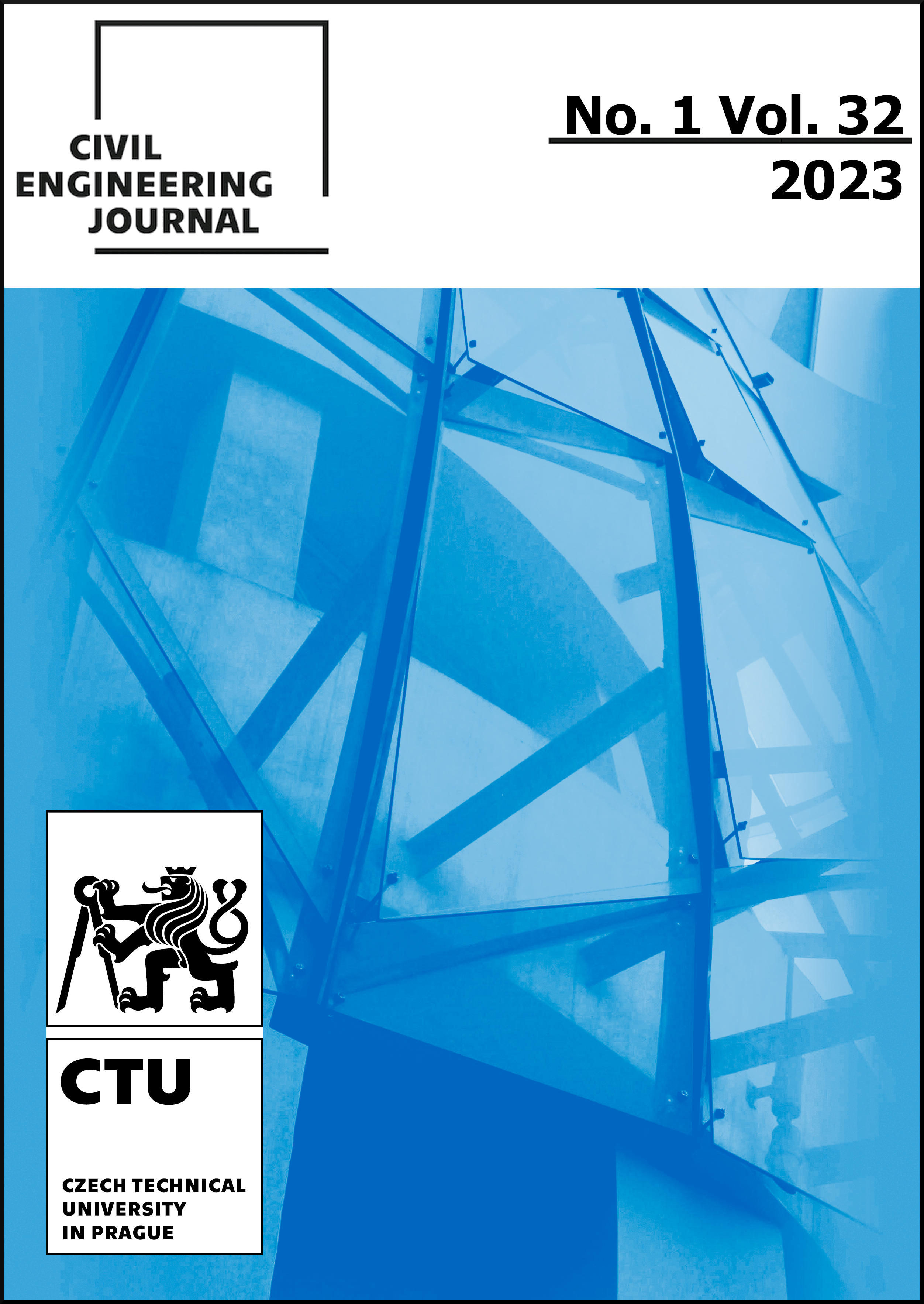EXPERIMENTAL INVESTIGATION OF PERVIOUS CONCRETE TO IMPEL IT IN THE INFRASTRUCTURE OF PAKISTAN
DOI:
https://doi.org/10.14311/CEJ.2023.01.0007Keywords:
Infrastructure, Pervious concrete, Compressive strength, Infiltration rate, Mix design, Asphalt premix, Traditional concreteAbstract
Pakistan is facing adverse environmental issues peculiarly in major cities. The condition gets worst during monsoon period when the whole city faces the urban flooding due to stagnation of storm water on all major streets and areas. The main reason is the lack of infra-structure to mitigate the crisis which is faced by the country during whole rainfall season. The introduction of Pervious Concrete in major pavement infra-structure can easily limit the problems of sump of rain water. As a part of road infrastructure, the upper layer of pavement can be pervious, making runoff water to move to sub-base. This paper offers the exploratory research to ascertain the compressive strengths and infiltration rate of different samples of Porous Concrete following the American Concrete Institute guidelines. The experiments were done with varying the properties of Pervious Concrete. The effects which were considered are curing time, mix proportion, percentage quantity of fine aggregate, ratio of water to cement and varying coarse aggregate size. The mix design ratio considered were 1:4, 1:5 and 1:6. For further experiment of infiltration rate, the custom slab was formed with dimensions 2’x1’x4” and was tested for all the desired ratios. For the purpose of cost comparison, a fixed size on land is kept as standard. The cost is compared for construction on the land, using three different materials: Pervious concrete, Traditional concrete and Asphalt premix.It was showed that the Traditional concrete is cheaper than the Pervious and Asphalt layer but Pervious concrete is also economical than Asphalt layer.
Downloads
References
REFERENCES
Kevern, J., Wang ,K., Suleiman, M.T.,& Schaefer,V. R. (2006). Mix Design Development for Pervious Concrete in cold weather climates.Research gate. https://www.researchgate.net/publication/237226150_Mix_Design_Development_for_Pervious_Concrete_in_Cold_Weather_Climates
Elango, K. S., & Revathi, V. (2019). Infiltration and clogging characteristics of pervious concrete Asian Journal of Civil Engineering, 20, Pg 1119-1127
https://doi.org/10.1007/s42107-019-00170-w
Neithalath, N. , Bentz , D.P ., & Sumanasooriya, M. S.( 2010). Predicting the Permeability of Pervious Concrete. A Contribution from ACI Committee 236.Concrete international , Pg 35-40
Ong, S.K., Wang,K.,Ling,Y., Shi,G. (2016). Pervious Concrete Physical Characteristics and Effectiveness in Stormwater Pollution Reduction.Institute for Transportation.IOWA State University. http://lib.dr.iastate.edu/intrans_reports/197
Tripathi,D.P.M., Hussain, S.M.A. ,& Madhav,P.(2017). An Experimental Study on Pervious Concrete (Mix-Ratio, Strength and Porous Properties). International Journal of Engineering Research & Technology (IJERT) ISSN: 2278-0181 ,Vol. 6, Issue 12, , Pg100-103 https://doi.org/10.17577/IJERTV6IS120054
Liu,H., Luo,G., Wei,H., & Yu,H.( 2018). Strength, Permeability, and Freeze-Thaw Durability of Pervious Concrete with Different Aggregate Sizes, Porosities, and Water-Binder Ratios.MDPI Appl. Sci.,8,1217. https://doi.org/10.3390/app8081217
Pareek,K. & Hong,Y.M.(2019). Prediction of Permeability and Compressive strength for Pervious Concrete, IOP Conference Series: Materials Science and Engineering, 812(2020) 012013
Gowri,T.(2020). Experimental Study of Pervious Concrete.International Journal of Scientific Research & Engineering Trends, Volume 6, Issue 4, Pg 2081-2087
Mahboub,K.C., Canler,J., Rathbone,R., Robl,T., & Davis,B.(2009). Pervious Concrete: Compaction and Aggregate Gradation.ACI Materials Journal, Vol 6, Issue No.6, Pg 523-528
ACI Committee 522.(2010).Report on Pervious Concrete. ACI 522R-10, Pg 522R(1-38)
Rahangdale,S., Maran,S.,Lakhmani,S.,& Gidde,M.(2017) .STUDY OF PERVIOUS CONCRETE. International Research Journal of Engineering and Technology (IRJET), Volume 04, Issue 06 , Pg 2563-2566.
Pratap,S.H.,Kapil,S. ,Rakesh,S., & Kumar,K.S.(2016). Enhancement the Strength of Pervious Concrete with Different Water Cement Ratio and Admixture. International Journal of Engineering Research & Technology (IJERT) ISSN: 2278-0181, Vol.5, Issue01 ,Pg 582-588,
https://doi.org/10.17577/IJERTV5IS010465
Ajamu,S.O., Jimoh,A.A.,& Oluremi,J.R.(2012). Evaluation of Structural Performance of Pervious Concrete in Construction. International Journal of Engineering and Technology ,Volume 2, No. 5, Pg 829-836.
Dr.Medhani,R. , Mr Khan,W., & Dr. Arhin,S.(2014). Evaluation of Mix Designs and Test Procedures for Pervious Concrete. Research, Development & Technology Transfer Program.
Chopra,M., Wanielista,M., & Mulligan,A.M.(2007). Compressive Strength of Pervious Concrete Pavements. Final Report, Storm water Management Academy, University of Central Florida
Costa,F.B.P. ,Lorenzi,A.,Haselbach,L., & Silva Filho,L.C.P.(2018). Best practices for pervious concrete mix design and laboratory tests. IBRACON Structures and Materials Journal, Volume 11,Number 5, Pg.1151-1159, ISSN1983-4195.
https://doi.org/10.1590/s1983-41952018000500013
Maguesvari,M.U., & Narasimha,V.L.(2013). Studies on Characterization of Pervious Concrete for Pavement Applications.2nd Conference of Transportation Research Group of India (2nd CTRG), Procedia - Social and Behavioral Sciences 104, Pg 198 - 207.
https://doi.org/10.1016/j.sbspro.2013.11.112
Wang, K., Schaefer, V. R., Kevern,J. T., & Suleiman, M.T.(2006). Development of Mix Proportion for Functional and Durable Pervious Concrete. Research gate. NRMCA Concrete Technology Forum: Focus on Pervious Concrete
Kovac,M.,& Sicakova,A.(2017). Changes of strength characteristics of pervious concrete due to variations in water to cement ratio. 1st International Conference on Advances in Environmental Engineering (AEE 2017), Conf. Series: Earth and Environmental Science 92 012029. https://doi.org/10.1088/1755-1315/92/1/011001
Kumar,S.R.(2015). Characteristic Study on Pervious Concrete. International Journal of Civil Engineering and Technology (IJCIET), Volume 6, Issue 6, , Pp. 165-176
Downloads
Published
Issue
Section
License
Copyright (c) 2023 Author

This work is licensed under a Creative Commons Attribution-NonCommercial 4.0 International License.
Authors who publish with this journal agree to the following terms:
- Authors retain copyright and grant the journal right of first publication with the work simultaneously licensed under a Creative Commons Attribution License that allows others to share the work with an acknowledgement of the work's authorship and initial publication in this journal.
- Authors are able to enter into separate, additional contractual arrangements for the non-exclusive distribution of the journal's published version of the work (e.g., post it to an institutional repository or publish it in a book), with an acknowledgement of its initial publication in this journal.
- Authors are permitted and encouraged to post their work online (e.g., in institutional repositories or on their website) prior to and during the submission process, as it can lead to productive exchanges, as well as earlier and greater citation of published work (See The Effect of Open Access).
How to Cite
Accepted 2023-03-14
Published 2023-04-30











